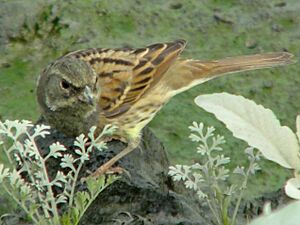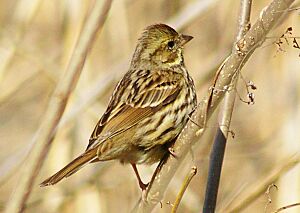Black-faced bunting facts for kids
Quick facts for kids Black-faced bunting |
|
|---|---|
 |
|
| In Taiwan | |
| Conservation status | |
| Scientific classification |
The black-faced bunting (Emberiza spodocephala) is a small bird that belongs to the bunting family. Buntings are a group of birds that are now usually seen as different from finches.
The name Emberiza comes from an old German word for bunting. The second part of its name, spodocephala, comes from ancient Greek words. Spodos means "ashes" and kephalos means "headed." This describes the bird's ash-colored head.
Contents
About the Black-faced Bunting
The black-faced bunting is a type of passerine bird. Passerines are also known as "perching birds." They have feet designed to grip branches.
This bird is similar in size to a reed bunting. It is about 16 centimeters (6.3 inches) long. Its general look and how it finds food on the ground make it seem a bit like a dunnock. But it has the strong bill of a bunting.
Where It Lives
Black-faced buntings breed in southern Siberia. Their breeding range stretches all the way to northern China. They are migratory birds. This means they travel long distances each year.
They spend their winters in places like north-east India, southern China, and northern parts of south-east Asia. Sometimes, a black-faced bunting might fly off course. It can become a very rare visitor, called a vagrant, to western Europe.
What It Looks Like
The breeding male black-faced bunting has a dark grey head. There is a mix of yellow-green and black between its bill and eye. Its upper parts are brown and have many black streaks. However, its rump, which is the lower back, is plain brown. The tail is also a dark brown color.
The underside of the male bird is yellowish-white. It has some thin, dark brown streaks on its sides. The bird has a strong, pink bill.
Female birds and young birds look a bit different. Their head pattern is not as strong. They have olive-grey cheeks. They also have a faint creamy-white stripe above their eye, called a supercilium. Their undersides are creamy-yellow. These parts are heavily streaked with dark brown.
Its Call and Nest
The call of the black-faced bunting sounds like a tzii or tzee. People often describe it as sounding very "metallic." It is a very short call and not really a long song.
These birds build their nests on trees or on the ground. A female black-faced bunting usually lays about four to five eggs.
Habitat and Food
During the breeding season, black-faced buntings live in dense bushes. They prefer areas along streams and rivers in the taiga zone. The taiga is a large forest area found in cold northern regions.
Their natural diet mainly consists of seeds. When they are feeding their young, they also eat insects. In winter, they stay close to water. They can be found in farmland or other open areas with bushes.



